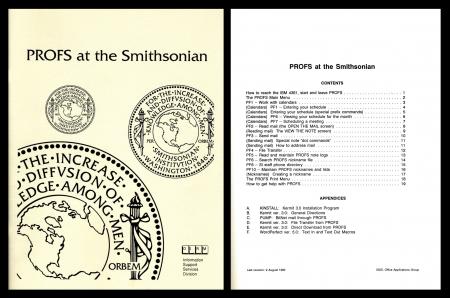Many of us read, write and send emails every day, but when did it all start at the Smithsonian?
In 1980 Smithsonian staff had typewriters and telephones on their desk, with one or two FAX machines per office. The Smithsonian operated a single general purpose computer, the Honeywell mainframe, for all Smithsonian data processing applications and which did not include an email application. Desktop computers were nowhere to be found.
When the Museum Support Center (MSC) was under construction in 1982, the Smithsonian was also researching an interactive computer system for the new facility to document and manage the movement of tens of millions of specimens and objects to the new Suitland, Maryland, storage facility. One of the secondary requirements was a "mail message system." Six of the seven responding vendors offered an electronic mail system. A VAX-11/750 from Digital Equipment Corporation (DEC) was selected, and was operational in April 1983.
Email was used by the MSC software development team before the end of 1983, and its use was greatly expanded the following year, 1984. The period of 1985-1988 saw rapid technological advances in networking, minicomputers, personal computers, and Local Area Network (LAN) systems. Many different Smithsonian offices and bureaus (including National Museum of American History, National Museum of Natural History, Smithsonian Libraries, and the Office of Protection Services) acquired computer systems during this period which included email software. However at this time, most computer networks were proprietary networks. Initially a person could only exchange email with other people on the same email system. The development of standards, the adoption of standards, and inter-operability between different systems would arrive later.
The BITNET (Because It’s There Network) network supported both email and batch file transfer. This network linking more than 3,000 computers, principally in academic institutions, demonstrated to the Smithsonian community the speed and power of international email communications. The Smithsonian applied for membership in BITNET on August 15, 1986, and the IBM-4381 mainframe was connected later that year with a node name of SIVM.
Later, within the SI, the BITNET network was extended to two additional nodes: SIMSC and SIMNH. SIVM and SIMSC were still active BITNET nodes in March 1994, but probably disconnected soon after that. Listserv software was developed for BITNET, and mailing lists such as, MUSEUM-L (with 5,184 subscribers today) became very popular. However, with the rapid growth of the Internet, BITNET’s limitations became apparent, and its popularity and the use of BITNET diminished quickly.
In July 1992 the Smithsonian network was connected to the Internet and many internal email systems achieved greater interoperability as well as external connectivity, through the adoption of the SMTP Internet email standard. Smithsonian staff could communicate with colleagues globally, without waiting for a snail-mail reply.

I published the first Smithsonian Email Directory (March 1994) which listed ten different computer email systems (Internet hosts) and 4,846 email addresses. An unknown number of staff had email addresses on different computer systems, such as my own in both the SIMSC and SIMNH systems. This Directory made the following observation:
Electronic mail has evolved from many local e-mail applications to a state where most e-mail applications can now exchange messages freely with each other. Sometimes additional software, hardware, and/or network connections maybe required. However, there are still a few isolated islands in the archipelago, cut off from the rest of the Smithsonian and the rest of the world!
The largest email system at the Smithsonian, PROFS, was operated by OIRM (Office of Information Resource Management), and ran on an IBM-9121 mainframe, with 2,398 email addresses. PROFS supported both email as well as calendaring; the PROFS user manual was prepared in August 1990. This suggests that perhaps only 50-60% of the staff had email in 1994. GroupWise became the dominant email system in the late 1990’s, while competing with some offices using Lotus Notes and Microsoft Exchange email systems.

Initially most people treated email as very informal communication, not worthy of being saved or archived. However, as email usage spread and it became the common method of conducting business, this attitude changed. The possibility that email correspondence could be historically valuable or an official record was recognized in an informative 1997 pamphlet distributed to Smithsonian staff. More recent guidance is available to the Smithsonian community and the general public on the Archives website.
Eventually a decision was made to have one centrally supported email system for the Smithsonian. A single unified Smithsonian-wide email system was achieved when the last office was converted to Microsoft Exchange in 2005, more than twenty years after the first email was sent.
Related Resources
- Electronic Records - Responsible Recordkeeping; Email Records, 2007, Smtihsonian Institution Archives
- You've Still Got Mail, The Bigger Picture blog, Smtihsonian Institution Archives
Produced by the Smithsonian Institution Archives. For copyright questions, please see the Terms of Use.

Leave a Comment